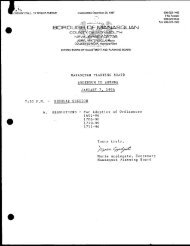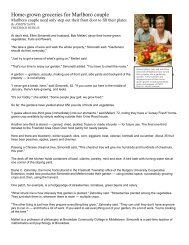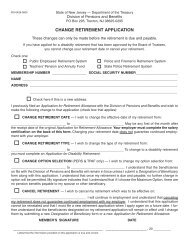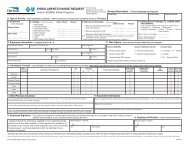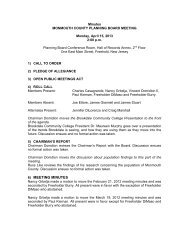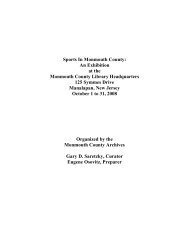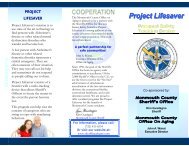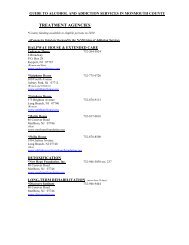NATURAL and CULTURAL FEATURES of MONMOUTH COUNTY
NATURAL and CULTURAL FEATURES of MONMOUTH COUNTY
NATURAL and CULTURAL FEATURES of MONMOUTH COUNTY
Create successful ePaper yourself
Turn your PDF publications into a flip-book with our unique Google optimized e-Paper software.
sent raiding parties into Barnegat Inlet from a blockading fleet (NJDMVA, 2008). In 1813, the<br />
US Army built a temporary fortification at S<strong>and</strong>y Hook called Fort Gates (renamed Fort<br />
Hancock in 1895), <strong>and</strong> in 1814 the NJ militia was organized to combat British attacks until the<br />
Treaty <strong>of</strong> Ghent ended the war later that year on December 24 th (OCCHC, 2008; SSH, 2008)<br />
What is much less known is that during WWII, the coastal waters from New Engl<strong>and</strong> to Florida,<br />
including Monmouth County, were patrolled by German U-Boats during Operation Drumbeat,<br />
Germany’s invasion <strong>of</strong> shipping lanes along the US East Coast that was planned by Hitler just 5<br />
days after Pearl Harbor (Bilby, 2008; FTH, 2008; Larson, 2008). The first attack took place on<br />
January 12, 1942, when the British passenger steamship “Cyclops” was sunk 300 miles <strong>of</strong>f Cape<br />
Cod; 2 days later, the “Norness” was sunk 60 miles <strong>of</strong>f Montauk Point, Long Isl<strong>and</strong>, during the<br />
first attack in the NY Bight (FTH, 2008; Larson, 2008). A couple <strong>of</strong> weeks later on January 26,<br />
the “RP Resor”, owned by St<strong>and</strong>ard Oil (Exxon) <strong>and</strong> carrying 78,729 barrels <strong>of</strong> crude oil, was<br />
torpedoed about 20 miles east <strong>of</strong> the Manasquan Inlet, where it burned <strong>and</strong> drifted for 2 days<br />
until it sank in 130’ <strong>of</strong> water, 31 miles east <strong>of</strong> Barnegat Light (EDC, 2008). The 2-day fire was<br />
so spectacular that crowds gathered at Asbury Park to watch (EDC, 2008; Berg, 2008).<br />
During the first 6 months <strong>of</strong> 1942, as 397 merchant ships <strong>and</strong> tankers were being torpedoed<br />
along the East Coast by the U-Boat “wolf packs”, residents near Wreck Pond left turpentine on<br />
their back porch so they could clean their feet <strong>of</strong> the tarry crude oil that was washing ashore; <strong>and</strong><br />
in early spring <strong>of</strong> 1942, students were sent home from school in Leonardo when a sub was<br />
spotted <strong>of</strong>f S<strong>and</strong>y Hook (Bilby, 2008; Cassone, 2008; DD, 2008; FTH, 2008). Shore-bound<br />
tourists were only able to enjoy their 4 th <strong>of</strong> July weekend in 1942 after 300 workers, including 65<br />
from the Works Progress Administration (WPA), had removed all the oil, tarballs, <strong>and</strong> wreckage<br />
that had washed up in late June along 7 miles <strong>of</strong> beaches from Belmar to Manasquan (Bilby,<br />
2008; New York Times, 1942).<br />
Three days after Pearl Harbor, mariners were notified that a “mined area covering the approaches<br />
to New York Harbor has been established. Incoming vessels will secure directions for safe<br />
navigation from patrol vessels stationed <strong>of</strong>f Ambrose Channel Entrance" (FTH, 2008). A<br />
submarine net <strong>and</strong> booms were eventually laid by the US Navy Net Depot <strong>of</strong> Bayonne across the<br />
Verrazano Narrows, from Norton's Point in Coney Isl<strong>and</strong> to H<strong>of</strong>fman Isl<strong>and</strong> (FTH, 2008). On<br />
January 15, 1942, the U-123, which had sunk the Norness <strong>of</strong>f Montauk Point the day before,<br />
cruised west along Long Isl<strong>and</strong>, navigating with a NYC tourist map <strong>of</strong>f the Parachute Jump <strong>and</strong><br />
Wonder Wheel on Coney Isl<strong>and</strong>, so close that they almost beached in the shallows along the<br />
southward curve <strong>of</strong> the Rockaways near Fort Tilden (FTH, 2008; VWHCAP, 2008). NYC<br />
Mayor Fiorello La Guardia later questioned whether “the Republic could even guarantee the<br />
defense <strong>of</strong> Coney Isl<strong>and</strong>" (FTH, 2008). It is now known that slogans such as “Loose Lips Sink<br />
Ships” were more effective at calming the public than at frustrating the Germans submarines,<br />
who located their targets by intercepting ship radio transmissions (FTH, 2008).<br />
The U-Boats attacked at night when the target boats were silhouetted against the shoreline, <strong>and</strong><br />
teenagers in NJ took their dates to the beach to watch “submarine races” (VWHCAP, 2008).<br />
East Coast cities, initially reluctant to order blackouts, were finally ordered to “dim-out”<br />
waterfront <strong>and</strong> sky signs on April 18, 1942, <strong>and</strong> blackouts were imposed by May (FTH, 2008;<br />
Larson, 2008). The US Coast Guard Reserve (now USCG Auxiliary) formed in 1939, the same<br />
year that the war had begun in Europe. They checked “commercial fishing boats <strong>and</strong> their crews<br />
upon departure <strong>and</strong> arrival at docks in Wildwood, Two Mile, <strong>and</strong> Cape May to guard against<br />
their carrying supplies to enemy vessels <strong>of</strong>f-shore or bringing enemy agents ashore. . . .” (Larson,




